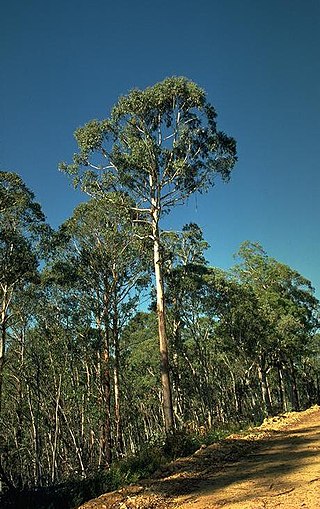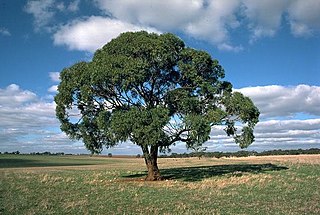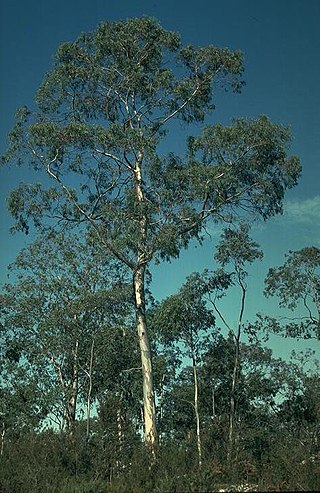
Eucalyptus delegatensis, commonly known as alpine ash, gum-topped stringybark, white-top and in Victoria as woollybutt, is a species of tree that is endemic to southeastern Australia. It has a straight trunk with rough, fibrous to stringy bark on the lower half of the trunk, smooth white bark above, lance-shaped to curved adult leaves, flower buds in groups of between seven and fifteen, white flowers and barrel-shaped or hemispherical fruit.

Eucalyptus obliqua, commonly known as messmate stringybark or messmate, but also known as brown top, brown top stringbark, stringybark or Tasmanian oak, is a species of tree that is endemic to south-eastern Australia. It has rough, stringy or fibrous bark on the trunk and larger branches, smooth greyish bark on the thinnest branches, lance-shaped to curved adult leaves, flower buds in groups of seven to fifteen or more, white flowers and cup-shaped or barrel-shaped fruit.

Eucalyptus saligna, commonly known as the Sydney blue gum or blue gum, is a species of medium-sized to tall tree that is endemic to eastern Australia. It has rough, flaky bark near the base of the trunk, smooth bark above, lance-shaped to curved adult leaves, flower buds in groups of seven, nine or eleven, white flowers and cylindrical to conical or cup-shaped fruit.

Eucalyptus pulverulenta, commonly known as silver-leaved mountain gum, is a species of straggly tree or mallee that is endemic to southern New South Wales. It has smooth bark, egg-shaped, heart-shaped or round, sessile leaves arranged in opposite pairs, flower buds in groups of three, white flowers and cup-shaped to cylindrical fruit.

Eucalyptus baxteri, commonly known as brown stringybark, is a medium-sized tree that is endemic to the south-east of mainland Australia. It has rough, stringy bark to the thinnest branches, lance-shaped or curved adult leaves, green to yellow flower buds in groups of between nine and fifteen, and cup-shaped or hemispherical fruit.

Eucalyptus odorata, commonly known as peppermint box, is a species of mallee or a small tree that is endemic to South Australia. It has rough, hard bark on the trunk and larger branches, smooth greyish bark on the thinner branches, lance-shaped adult leaves, flower buds in groups of between seven and eleven, white flowers and cylindrical or barrel-shaped fruit.

Eucalyptus deanei, commonly known as mountain blue gum, round-leaved gum, or Deane's gum, is a species of large tree endemic to New South Wales. It has smooth bark, lance-shaped leaves that are paler on the lower surface, flower buds in groups of seven to eleven, white flowers and cup-shaped to bell-shaped fruit.

Eucalyptus cephalocarpa, commonly known as mealy stringybark or silver stringybark is a species of small to medium-sized tree, that is endemic to south-eastern Australia. It has rough, fibrous bark on the trunk and branches, lance-shaped adult leaves, Flower buds arranged in groups of seven, white flowers and conical, bell-shaped or hemispherical fruit.

Eucalyptus parramattensis, commonly known as the Parramatta red gum or drooping red gum, is a species of small to medium-sized tree that is endemic to eastern New South Wales. It has smooth, mottled bark, lance-shaped to curved adult leaves, flower buds in groups of seven, white flowers and hemispherical fruit.

Eucalyptus burgessiana, commonly known as the Faulconbridge mallee ash, is a small tree or mallee that is endemic to New South Wales. It has smooth bark, narrow lance-shaped or curved adult leaves, flower buds arranged in groups of between seven and eleven, white flowers and barrel-shaped or cup-shaped flowers.

Eucalyptus tenuiramis, commonly known as the silver peppermint, is a species of small to medium-sized tree that is endemic to southeastern Tasmania. It has smooth bark, broadly lance-shaped adult leaves, flower buds in groups of nine to fifteen, white flowers and cup-shaped, hemispherical or conical fruit.

Eucalyptus laevopinea, commonly known as the silver top stringybark, is a tree that is endemic to eastern Australia. It has rough, stringy greyish bark on the trunk and larger branches, glossy green, lance-shaped adult leaves, flower buds in groups of between seven and eleven, white flowers and hemispherical or shortened spherical fruit.

Eucalyptus stricta, commonly known as Blue Mountains mallee ash, is a mallee that is endemic to eastern New South Wales. It has smooth, mottled bark, often with insect scribbles, linear to lance-shaped adult leaves, flower buds in groups of seven, white flowers and urn-shaped to barrel-shaped fruit.

Eucalyptus blaxlandii, commonly known as Blaxland's stringybark, is a tree that is endemic to south eastern New South Wales. It is a stringybark with lance-shaped adult leaves, flower buds arranged in group of nine or eleven, white flowers and hemispherical fruit.

Eucalyptus ligustrina, commonly known as the privet-leaved stringybark, is a species of shrub, mallee or small tree that is endemic to New South Wales. It has rough, stringy bark, lance-shaped to egg-shaped adult leaves, flower buds in groups of between seven and fifteen, white flowers and hemispherical or shortened spherical fruit.

Eucalyptus dendromorpha, the Budawang ash or giant mallee ash is a species of tree endemic to southeastern Australia. It has rough, compacted bark on the lower part of the trunk, smooth white to cream-coloured bark above, lance-shaped to curved adult leaves, flower buds in groups of between seven and eleven, white flowers and cup-shaped or barrel-shaped fruit.

Eucalyptus benthamii, commonly known as Camden white gum, Bentham's gum, Nepean River gum, kayer-ro or durrum-by-ang, is a species of tree that is endemic to New South Wales. It has mostly smooth bluish grey or white bark, lance-shaped to curved adult leaves, flower buds arranged in groups of seven, white flowers and cup-shaped, bell-shaped or conical fruit.

Eucalyptus mckieana, commonly known as McKie's stringybark, is a species of tree that is endemic to New South Wales. It has rough, stringy bark on the trunk and branches, lance-shaped to curved adult leaves, flower buds in groups of between seven and eleven, white flowers and cup-shaped, barrel-shaped or hemispherical fruit.

Eucalyptus conglomerata, commonly known as the swamp stringybark, is a species of straggly tree or mallee that is endemic to Queensland. It has rough, fibrous "stringybark" lance-shaped to oblong adult leaves, flower buds in groups of eleven or more, white flowers and more or less barrel-shaped fruit.

Eucalyptus sphaerocarpa, commonly known as the Blackdown stringybark, is a species of tall forest tree that is endemic to Queensland. It has rough, stringy bark on the trunk and branches, lance-shaped to curved adult leaves, flower buds in groups of seven, nine or eleven, white flowers and shortened spherical fruit.























